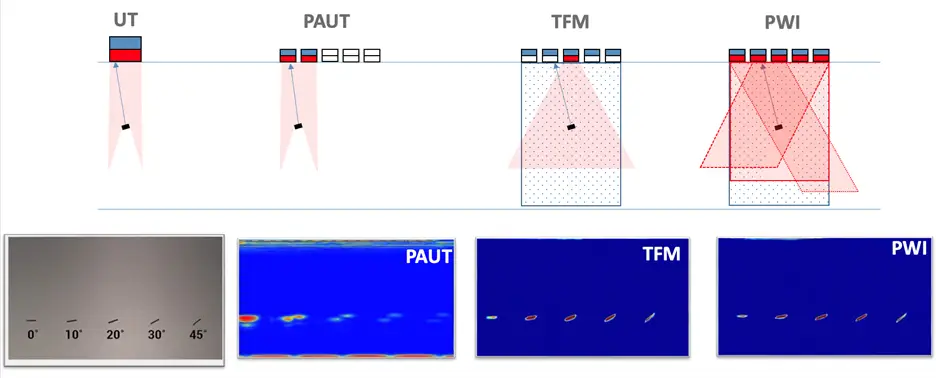Research in ultrasonic testing
TPAC & Research in Ultrasonic Testing
TPAC has a long history of providing ultrasound instruments for research. The first reason is that TPAC proposes a very diverse portfolio of ultrasound measurement systems. This is also due to the fact that an Application Programming Interface (API) is proposed with all our equipments. This API allows researchers to freely program the hardware and to record the data that are needed for research purpose.
TPAC proposes a large variety of data acquisition and imaging/beamforming techniques through a large family of hardware and software tools. Based on a strong knowledge of ultrasound acquisition systems, starting with conventional ultrasonics, the hardware can also include phased array (PAUT) standard techniques. TPAC has also worked since about a decade on the latest imaging techniques such as the Total Focusing Method, Plane Wave Imaging, surface-adaptive techniques and more. See Figure 1 about the technologies that we propose.
Needs in research have several facets and TPAC can bring a solution for many of them. On one hand, some research topics demand a simple system for raw data acquisition but with full control of the settings. TPAC can offer this thanks to its complete hardware offer and its API in Matlab, Python, Labview and C++. On the other hand, some research topics ask for an easy-to-use system and software to do lab inspection or research in imaging. This can be achieved thanks to reliable and fast hardware but also with highly featured software dedicated to research such as ARIA and Prelude R&D.

Figure 1. Technologies proposed by TPAC.
Study Cases / Recent topics of research
- Nondestructive testing
- Material characterization
- Concrete characterization
- Air-coupled ultrasound
- Additive manufacting
- Beamforming
- Guided waves
- Nonlinear acoustics
- Signal processing
- Machine learning
- Medical imaging
- Ultrasound probe development
Our solutions
TPAC proposes basically 3 devices that can be beneficial for research:
Pilot
A multichannel (UT) device with 8 pulsers and 8 receivers. Pulser can be Arbitrary Waveform Generator (AWG) or negative pulse.
Explorer
A phased-array device with a small form factor that can be used to embed on a scanner or robot. It can drive up to 64 channels in phased array (PAUT) or TFM-like techniques (TFM, PWI, etc.).
Pioneer
The best platform for research with all features (AWG, transfer speed, etc.). Starting from 64 channels, 128, 256 or more can be proposed. The Pioneer includes UT, PAUT, and TFM-like techniques.
Our Open Platform Software for Research – Aria
Aria is an open format software for R&D, academia, and laboratory applications. Dedicated to ultrasonic imaging, Aria offers a powerful software suite, for exploration of all the TFM-based reconstruction technologies such as SAFT, TFM, and more advanced imaging techniques such as PWI, CWI, DWI, XWI and, in addition, adaptive (complex geometries), nonlinear acoustics, and much more. Apply extensive post-processing to analyze and manage your results.
Benefits
- Versatile system family for all needs
- API for custom control (sequences, gains, filters, etc.)
- API in Matlab, C++, Python, Labview, etc.
- Many code examples
- Toolbox for beamforming (TFM, PWI, Adaptive, etc.)
- Complete softwares for user-friendly and rapid use (Aria, Prelude R&D)
- Custom beamforming available in Aria
- Compatibility with third-part software (CIVA, ULTIS)
- Support from high-level scientists and engineers in various countries (USA, Canada, Europe, India, China, Korea, Japan)

